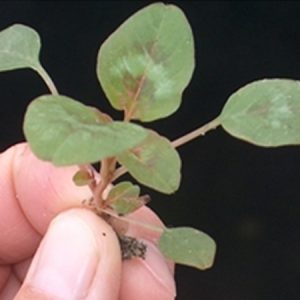Herbicide-resistant weed vexes Maryland, Delaware growers
 (May 19, 2017) – Farmers facing glyphosate- and ALS-resistant Palmer amaranth in their fields will need to take an integrated approach to managing the weeds this season and preventing further spread, says Ben Beale, University of Maryland Extension ag agent.
(May 19, 2017) – Farmers facing glyphosate- and ALS-resistant Palmer amaranth in their fields will need to take an integrated approach to managing the weeds this season and preventing further spread, says Ben Beale, University of Maryland Extension ag agent.
Beale, who works in Southern Maryland, says he saw fields that had extensive infestations of the herbicide-resistant weeds last year in both St. Mary’s and Charles counties. Herbicide-resistant Palmer amaranth also has been confirmed on the Eastern Shore of Maryland and in Delaware.
“Growers with Palmer amaranth should be prepared to rotate crops and chemistries,” Beale says. “They should think ahead about managing the seed bank in their fields, using cultural control methods like tillage or hand-pulling, and throughout the season and into harvest they should do everything they can to prevent the movement of seed from infested to clean fields.”
Beale evaluated 15 different regimens for controlling resistant Palmer amaranth in the summer of 2016 with funding from the Maryland Soybean Board. The board invests soybean checkoff funding to support research, marketing and educational projects.
He found that “any residual herbicide is better than no residual herbicide.” Residual products that worked well included products with Flumioxazin (Valor) including premixes of Fierce or Fierce XLT, and products with sulfentrazone (Authority) including premixes such as Broadaxe, Authority Elite, and Authority MTZ.
However, Beale says, none of the residual products provided consistently clean fields throughout the season. “This weed is a challenge,” he says. “Growers who have it need to address it now, and those who don’t need to do everything to prevent it from taking hold in their fields. That includes scouting hedgerows and insisting that combines are clean, with infested fields ideally being harvested last.”
The Maryland Soybean Board administers soybean checkoff funds for soybean research, marketing and education programs in the state. It is funded by farmers through an assessment of one-half of one percent of the net market value of soybeans at their first point of sale. One-half of the checkoff funds stay in Maryland for programs; the other half is sent to the United Soybean Board.
In Maryland, farmers grow about a half a million acres of soybeans, producing more than 20 million bushels of beans each year. With a value of $173 million to the state’s economy, soybeans are one of Maryland’s top crops. For more information on the Maryland Soybean Board, visit www.mdsoy.com.
# # #
For More Information:
Sandra Davis, Executive Director, Maryland Soybean Board
Office: 410.742.9500
sdavis26@verizon.net
